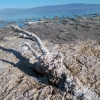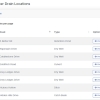
Field inspections of catch basins, manholes, culverts, and outfalls form the foundation of responsible stormwater management. These routine checks give municipalities an ongoing view of the condition of their drainage network and allow crews to identify issues long before they become flooding hazards or environmental threats. When crews understand what to look for and why these details matter, inspections become more than a checklist. They become an important part of protecting infrastructure, reducing maintenance costs, and safeguarding the health of streams and wetlands downstream.
A thorough inspection of a catch basin begins above the grate. Crews should look for debris accumulation, ponding water, surface cracking, and any signs that the basin has settled or shifted. Grates that sit out of level or frames that have separated from the surrounding pavement can allow water to bypass the structure, which increases the risk of localized flooding and pavement failure. After lifting the grate safely, workers should assess the interior condition. This includes checking the sump depth, noting sediment buildup, and inspecting walls for cracks or missing mortar. Excessive sediment usually signals upstream erosion or a lack of regular cleaning. Crews should also verify that inlet and outlet pipes are clear and properly aligned. Even a small obstruction can reduce flow and cause water to back up during storms.
Manhole inspections follow similar principles but require greater attention to structural integrity. Crews should confirm that the cover is seated securely and that no gaps exist around the rim that could allow infiltration or exfiltration. Inside the structure, workers should look for corrosion, missing steps, infiltration through joints, and debris in the channel. Infiltration appears as trickling groundwater entering through cracks or joints. This may seem minor, but it can overwhelm treatment systems or increase flows downstream. Any sign of displaced steps poses a safety risk and should be documented immediately. Because manholes often connect multiple segments of a drainage system, identifying defects early prevents widespread problems later.
Culverts require a broader field perspective because they interact directly with natural channels, road embankments, and surrounding soils. During inspection, crews should check both the inlet and outlet for blockages, sediment deposits, erosion, or debris that may restrict flow. The shape of the inlet can reveal whether the culvert is undersized or has been subject to high velocity flows. Scour holes, undermined headwalls, rust or corrosion on metal pipes, and joint separation in concrete sections all indicate structural stress. Inside the culvert, crews should look for deformation, water staining that suggests partial blockages, and evidence of debris racking during previous storms. Small changes noted early can prevent a complete structural failure, which often leads to road washouts or severe flooding.
Outfall inspections focus on how discharged water interacts with the receiving environment. Crews should look for erosion around the outlet, deposition of fine sediments, and any signs that flows are altering the natural channel. Vegetation around an outfall offers important clues. Dead or stressed plants may indicate contamination in the discharge or repeated high velocity flows. Crews should also watch for staining, odors, foam, or oily films that may signal illicit discharges. The condition of energy dissipators, riprap, or splash pads matters as well since these features are designed to slow water and prevent erosion. Missing or displaced stone often means that the outfall is handling more force than it was designed for.
Documentation is an essential part of every inspection. Clear notes, photos, and accurate GPS locations help supervisors prioritize repairs and schedule cleaning or maintenance. Even simple observations, such as noting that a sump is half full or that a culvert inlet is twenty percent blocked, offer meaningful information for long term asset management. When crews consistently document their findings, municipalities build a reliable maintenance history that guides capital planning, supports regulatory compliance, and helps prevent emergency failures.
The fundamentals of field inspections are not complicated, but they do require a practiced eye. By encouraging crews to slow down, observe conditions carefully, and understand the purpose of each structure, municipalities can strengthen the resilience of their stormwater networks. With regular inspections, even small towns can track their assets effectively, address problems before they worsen, and maintain healthier waterways for the communities they serve.
 Wetlands are often described as the kidneys of the watershed because they filter, slow, and transform the water that passes through them in ways that …
Wetlands are often described as the kidneys of the watershed because they filter, slow, and transform the water that passes through them in ways that …
 Field inspections of catch basins, manholes, culverts, and outfalls form the foundation of responsible stormwater management. These routine checks giv…
Field inspections of catch basins, manholes, culverts, and outfalls form the foundation of responsible stormwater management. These routine checks giv…
 Habitat disruption around drainage structures is often subtle at first, and many of the earliest signs tend to appear during ordinary field work rathe…
Habitat disruption around drainage structures is often subtle at first, and many of the earliest signs tend to appear during ordinary field work rathe…
 Harmful algal blooms have become one of the most pressing water quality problems in many regions, and their rise has been linked to a complicated blen…
Harmful algal blooms have become one of the most pressing water quality problems in many regions, and their rise has been linked to a complicated blen…
 The Salton Sea is one of California’s most unusual and tragic landscapes, a place shaped by accident, transformed by ambition, and ultimately pu…
The Salton Sea is one of California’s most unusual and tragic landscapes, a place shaped by accident, transformed by ambition, and ultimately pu…
 *The screenshots used in this article are from Roadwurx, an asset management software created for road maintenance departments. Managing a town’…
*The screenshots used in this article are from Roadwurx, an asset management software created for road maintenance departments. Managing a town’…